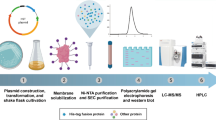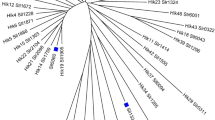Abstract
Light activation of NADP-linked glyceraldehyde-3-P dehydrogenase involves reductive cleavage of a disulfide bond. We have proposed that the inactivating disulfide locks the two domains of the enzyme, preventing catalysis, and we have tentatively identified the two critical cysteine residues in the chloroplast enzyme (D. Li, F.J. Stevens, M. Schiffer and L.E. Anderson (1994) Biophys J. 67: 29–35). We reasoned that if activation of this enzyme involves these cysteines that enzymes lacking one or both should be active in the dark and insensitive to reductants. One of these cysteines is present in the enzymes from Anabaena variabilis and Synechocystis PCC 6803 but the other is not. Consistent with the proposed mechanism, glyceraldehyde-3-P dehydrogenase is not affected by DTT-treatment in extracts of either of these cyanobacteria. Fructosebisphosphatase is DTT-activated in extracts of both of these cyanobacteria and glucose-6-P dehydrogenase is inactivated in Synechocystis, as in higher plant chloroplasts. Apparently reductive modulation is possible in these cyanobacteria but glyceraldehyde-3-P dehydrogenase is not light activated.
Similar content being viewed by others
References
Abola, EE, Bernstein, FC, Bryant, SH, Koetzle, TF and Weng, J (1987) Protein data bank. In: Allen, FH, Bergerhoff, G and Sievers, R (eds) Crystallographic Databases-Information Content, Software System, Scientific Application, pp 107–132. Data Commission of the Int'l Union of Crystallography, Bonn, Cambridge, Chester
Anderson, LE (1986) Light/dark modulation of enzyme activity in plants. In: Callow, JA (ed) Advances in Botanical Research. Vol 12, pp 1–46. Academic Press, New York
Austin, PA, Ross, IS and Mills, JD (1992) Light/dark regulation of photosynthetic enzymes within intact cells of the cyanobacterium Nostoc sp. Mac. Biochim Biophys Acta 1099: 226–232
Bernstein, FC, Koetzle, TF, Williams, GJB, Meyer, Jr, EF, Brice, MD, Rodgers, JR, Kennard, O, Shimanouchi, T and Tasumi, M (1977) The protein data bank: A computer-based archival file for macromolecular structures. J Mol Biol 112: 535–542
Biesecker, G, Harris, JI, Thierry, JC, Walker, JE and Wonacott, AJ (1977) Sequence and structure of D-glyceraldehyde 3-phosphate dehydrogenase from Bacillus stearothermophilus. Nature 266: 328–333
Bradford, MM (1976) A rapid and sensitive method for the quantitation of microgram quantities of proteins utilizing the principle of protein-dye binding, Anal Biochem 72: 248–254
Buchanan, BB (1991) Regulation of CO2 assimilation in oxygenic photosynthesis. Arch Biochem Biophys 288: 1–9
Cossar, JD, Rowell, P and Stewart, WDP (1984) Thioredoxin as a modulator of glucose-6-phosphate dehydrogenase in a N2-fixing cyanobacterium. J Gen Microbiol 130: 991–998
Crawford, NA, Sutton, CW, Yee, BC, Johnson, TC, Carlson, DC and Buchanan, BB (1984) Contrasting modes of photosynthetic enzyme regulation in oxygenic and anoxygenic prokaryotes Arch Microbiol 139: 124–129
Duggan, JX and Anderson, LE (1975) Light-regulation of enzyme activity in Anacystis nidulans (Richt.). Planta 122: 293–297
Fersht, A (1985) Enzyme Structure and Mechanism. 2nd Ed, pp 400–404. Freeman, New York
Harris, JI and Waters, M (1976) Glyceraldehyde-3-phosphate dehydrogenase. In: Boyer, PD (ed) The Enzymes, Vol 13, pp 1–49. Academic Press, New York
Li, D, Stevens, FJ, Schiffer, M and Anderson, LE (1994) Mechanism of light modulation: Identification of potential redox-sensitive cysteines distal to catalytic site in light-activated chloroplast enzymes. Biophys J 67: 29–35
Liaud, MF, Zhang, DX and Cerff, R (1990) Differential intron loss and endosymbiotic transfer of chloroplast glyceraldehyde-3-phosphate dehydrogenase genes to the nucleus. Proc Natl Acad Sci 87: 8918–8922
Martin, W, Brinkmann, H, Savona, C and Cerff, R (1993) Evidence for a chimeric nature of nuclear genomes: Eubacterial origin of eukaryotic glyceraldehyde-3-phosphate dehydrogenase genes. Proc Natl Acad Sci 90: 8692–8696
Muslin EH, Li D, Stevens FJ, Donnelly MI, Schiffer M and Anderson LE (1995) Engineering a domain-locking disulfide into a bacterial malate dehydrogenase produces a redox-sensitive enzyme Biophys J (in press)
Pacold, ME, Anderson, LE, Li, D and Stevens, FJ (1995) Redox sensitivity and light modulation of enzyme activity in the rhodophytes Gracilaria tikvahiae and Chondrus crispus. J Phycol 31: 297–301
Scanlan, DJ, Newman, J, Sebaiia, M, Mann, NH and Carr, NG (1992) Cloning and sequence analysis of the glucose-6-phosphate dehydrogenase gene from the cyanobacterium Synechococcus PCC 7942. Plant Mol Biol 19: 877–880
Scheibe, R (1991) Redox-modulation of chloroplast enzymes. A common principle for individual control. Plant Physiol 96: 1–3
Schmidt, A (1981) A thioredoxin-activated fructose-1,6-bisphosphatase from the cyanobacterium Synechococcus 6301. Planta 152: 101–104
Skarżyński, T, Moody, PCE and Wonacott, AJ (1987) Structure of holo-glyceraldehyde-3-phosphate dehydrogenase from Bacillus stearothermophilus at 1.8 Å resolution. J Mol Biol 193: 171–187
Udvardy, J, Borely, G, Juhasz, A and Farkas, G (1984) Thioredoxins and the redox modulation of glucose-6-phosphate dehydrogenase in Anabaena sp. strain PCC 7120 vegetative cells and heterocysts. J Bacteriol 157: 681–683
Author information
Authors and Affiliations
Rights and permissions
About this article
Cite this article
Pacold, M.E., Stevens, F.J., Li, D. et al. The NADP-linked glyceraldehyde-3-phosphate dehydrogenases of Anabaena variabilis and Synechocystis PCC 6803, which lack one of the cysteines found in the higher plant enzyme, are not reductively activated. Photosynth Res 43, 125–130 (1995). https://doi.org/10.1007/BF00042969
Received:
Accepted:
Issue Date:
DOI: https://doi.org/10.1007/BF00042969




